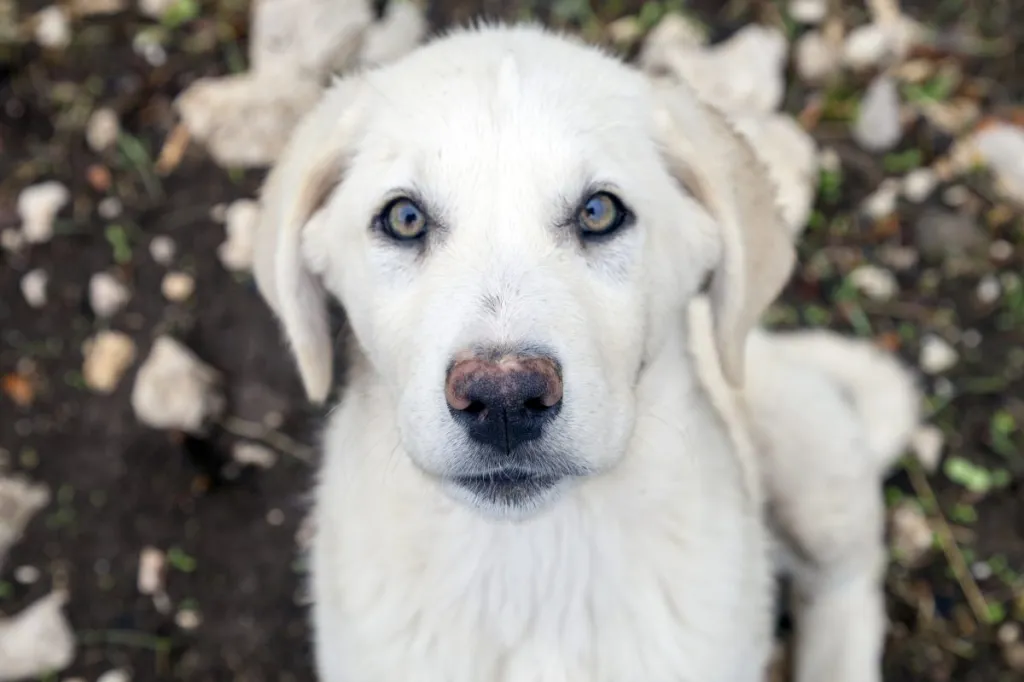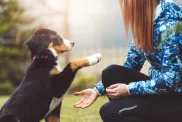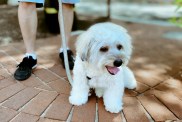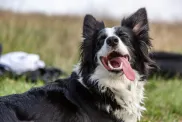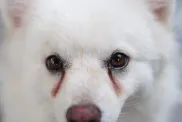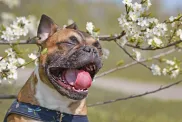The Akbash dog breed, originating from Turkey, is a magnificent and imposing shepherd known for its exceptional guardian instincts and unwavering loyalty. Sometimes confused with the Great Pyrenees, the Akbash also command attention with their striking white coats and confident demeanor.
Akbash dogs actively excel as livestock guardians, fearlessly protecting their charges from any predator. Their vigilant nature makes them an integral part of farm life, ensuring the safety of flocks and herds. With an acute awareness of their surroundings, Akbash dogs constantly monitor the perimeter, deterring potential threats with their authoritative presence.
We do not recommend this breed for first-time or inexperienced dog owners. They require plenty of exercise and mental stimulation, and they may accidentally knock over small children.
Temperament
Akbash dogs are gentle and protective towards their family, but they can also be suspicious and protective of strangers. They are independent thinkers and need to be trained with a firm but gentle hand. Akbash dogs are brave and courageous, and they will not hesitate to defend their family or flock from danger. They are also very loyal and enjoy spending time with their loved ones.
Quick Facts
- Origin: Turkey. The name “Akbash” is Turkish (Akbaş) for “white head.” They are closely related to the Kangal dog breed, another large livestock guardian dog from Turkey
- The United Kennel Club (UKC) officially recognized the breed in January 1998.
- Size: Large, with males standing 28-34 inches tall and weighing 80-140 pounds, and females standing 26-32 inches tall and weighing 60-120 pounds.
- Coat: White, with a medium-length double coat that sheds moderately year-round.
- Lifespan: 10-12 years.
- Health concerns: Hip dysplasia, elbow dysplasia, bloat, eye problems.
- Activity level: High. Akbash dogs need plenty of exercise, both physical and mental.
- Grooming needs: Regular brushing to remove dead hair and prevent mats.
Akbash Pictures
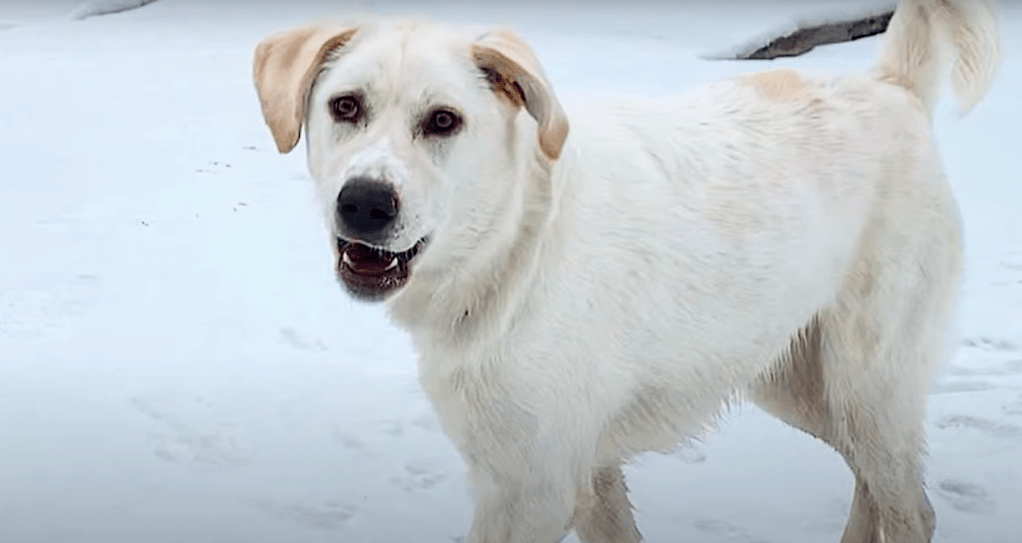
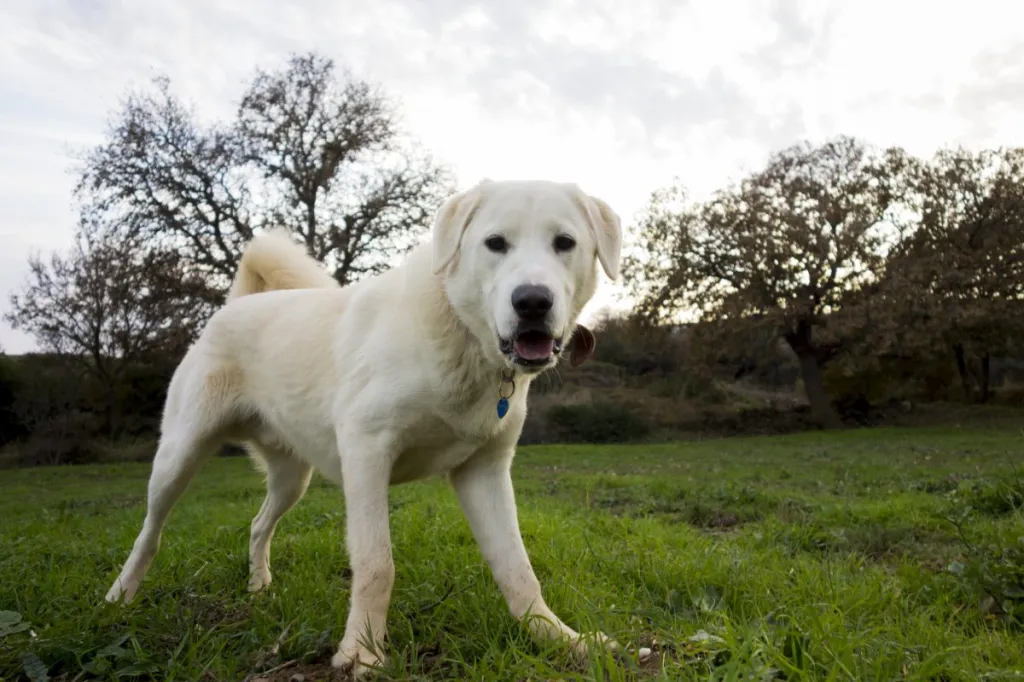
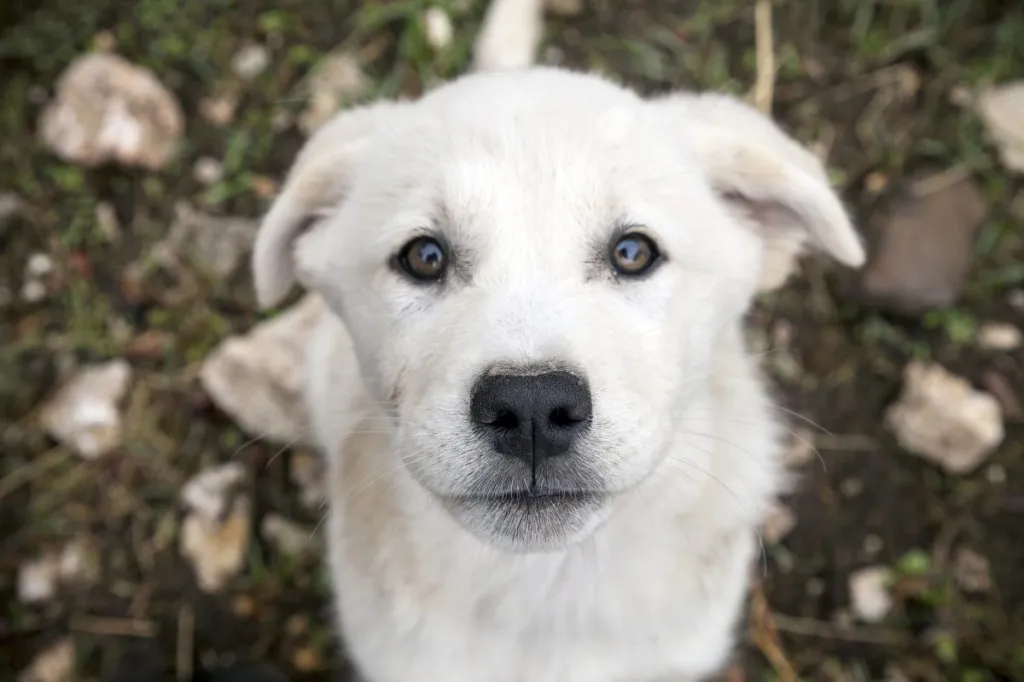
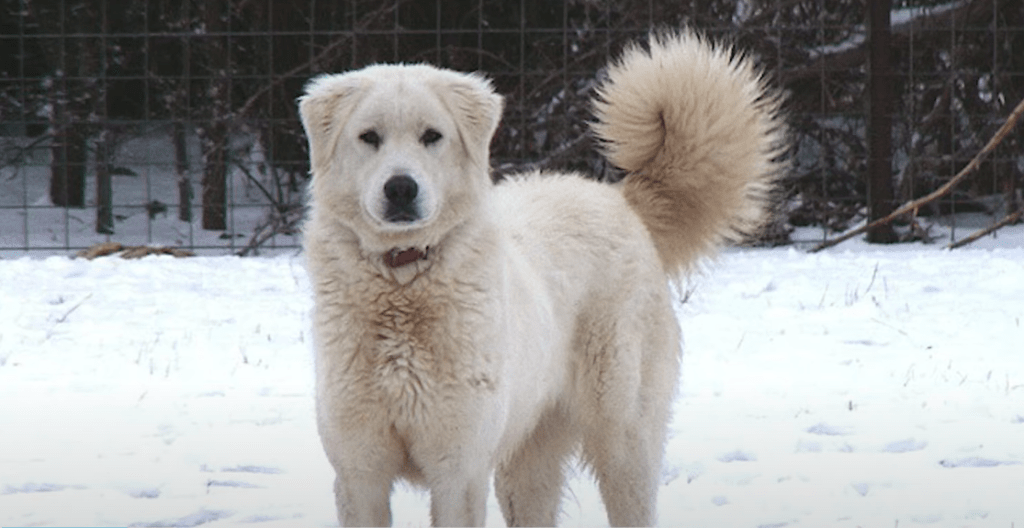
Adaptability
-
Adapts Well To Apartment Living
Looking for the best dog for your apartment? Contrary to popular belief, the suitability of dogs who adapt well to apartment living goes beyond its size. Apartment dwellers have a myriad of dog breeds to choose from as potential companions, with various factors to consider. Some large breeds can adapt well to apartment living and have lower activity levels. Others may require more space and possess higher energy levels. On the other hand, certain small dog breeds with abundant energy can still find contentment with indoor playtime or brisk walks.
However, when selecting a dog that adapts well apartments, it is essential to prioritize your neighbors. Opting for a pet that doesn’t excessively bark and behaves politely when encountering others in shared spaces like is crucial for maintaining a harmonious apartment environment.
In high-rise settings, it’s worth noting that numerous small dogs may exhibit a propensity for high energy and frequent barking. This makes them less suitable for apartment living. Therefore, desirable qualities in an apartment dog encompass being quiet, low-energy, and displaying polite behavior towards other residents.
Factors To Consider When Choosing A Dog For An Apartment
When considering dogs that adapt well to apartments, size alone should not be the sole determinant. Apartment dwellers have a wealth of dog breeds to choose from as potential furry companions. It’s important to remember that the size of your living space is just one factor to consider. While some larger breeds can adapt well to apartment living, with lower, others may require more space and have higher energy levels, making them less suitable for smaller apartments. Conversely, certain small dog breeds with higher energy levels can still thrive in apartments, finding contentment through indoor playtime or brisk walks. However, it is crucial to consider your neighbors’ comfort when selecting a dog. Opt for a pet that doesn’t bark excessively and behaves politely when interacting with others in shared spaces.
Therefore, it’s important to prioritize qualities such as being quiet, low-energy, calm indoors, and exhibiting good manners when living in close proximity to other residents. By considering these factors, you can find a dog that will adapt well to apartment living and create a harmonious living environment for everyone involved.
-
Good For Novice Owners
Some dogs are simply easier than others; they take to training better and are fairly easygoing. They’re also resilient enough to bounce back from your mistakes or inconsistencies.
Dogs who are highly sensitive, independent thinking, or assertive may be harder for a first-time dog parent to manage. You’ll get your best match if you take your dog-owning experience into account as you choose your new pooch.
If you’re new to dog parenting, take a look at 101 Dog Tricks and read up on how to train your dog!
-
Sensitivity Level
Some dogs will let a stern reprimand roll off their backs, while others take even a dirty look to heart. Low-sensitivity dogs, also called “easygoing,” “tolerant,” “resilient,” and even “thick-skinned,” can better handle a noisy, chaotic household, a louder or more assertive owner, and an inconsistent or variable routine. Do you have young kids, throw lots of dinner parties, play in a garage band, or lead a hectic life? Go with a low-sensitivity dog.
-
Tolerates Being Alone
Some breeds bond very closely with their family and are more prone to worry or even panic when left alone by their owner. An anxious dog can be very destructive–barking, whining, chewing, and otherwise causing mayhem. These breeds do best when a family member is home during the day or if you can take the dog to work.
-
Tolerates Cold Weather
Breeds with very short coats and little or no undercoat or body fat, such as Greyhounds, are vulnerable to the cold. Dogs with a low cold tolerance need to live inside in cool climates and should have a jacket or sweater for chilly walks. You can find a great jacket for your dog here!
-
Tolerates Hot Weather
Dogs with thick, double coats are more vulnerable to overheating. So are breeds with short noses, like Bulldogs or Pugs, since they can’t pant as well to cool themselves off. If you want a heat-sensitive breed, your dog will need to stay indoors with you on warm or humid days, and you’ll need to be extra cautious about exercising your dog in the heat.
All-around friendliness
-
Affectionate With Family
When it comes to unconditional love and unwavering loyalty, few animals can rival the affectionate nature of dogs. These remarkable creatures have earned their reputation as man’s best friend, and many breeds are particularly renowned for their love and devotion to their families. With their warm hearts and wagging tails, affectionate family dogs enrich the lives of their owners in countless ways.
One such breed known for its affectionate demeanor is the Golden Retriever. With their gentle temperament and friendly disposition, Golden Retrievers form deep bonds with their families. They eagerly participate in family activities, whether it’s a game of fetch in the yard or cuddling on the couch during a movie night. Their expressive eyes and ever-wagging tails are a testament to the joy they feel in the presence of their loved ones.
Another family-favorite breed is the Labrador Retriever. Renowned for their playful and patient nature, Labradors are excellent companions for children and adults alike. They readily engage in playtime with the kids, showcasing their boundless energy and enthusiasm. But when the day winds down, they seamlessly transition into loving and gentle cuddle buddies, comforting their family members with their warm presence.
Beyond specific breeds, mixed-breed dogs also have a special place in the hearts of families seeking affectionate companions. The shelter dogs, in particular, form deep connections with their adoptive families. They seem to understand the second chance they’ve been given and repay it with endless love and gratitude.
How To Know If A Dog Is Good With Families
The affectionate nature of family dogs extends beyond play and cuddles. Dogs have a remarkable ability to sense their owner’s emotions, offering comfort and support during difficult times. Whether it’s a wagging tail after a long day at work or a sympathetic nuzzle during moments of sadness, they prove time and again that they are attuned to their family’s needs.
It is important to note that not all dogs of the same breed will be equally affectionate. Some dogs may be more independent or aloof, while others may be more clingy or demanding of attention. The best way to find out how affectionate a dog is is to meet them in person and interact with them.
-
Kid-Friendly
Being gentle with children, sturdy enough to handle the heavy-handed pets and hugs they can dish out, and having a blasé attitude toward running, screaming children are all traits that make a kid-friendly dog. You may be surprised by who’s on that list: Fierce-looking Boxers are considered good with children, as are American Staffordshire Terriers (which are considered Pit Bulls). Small, delicate, and potentially snappy dogs such as Chihuahuas aren’t always so family-friendly.
**All dogs are individuals. Our ratings are generalizations, and they’re not a guarantee of how any breed or individual dog will behave. Dogs from any breed can be good with children based on their past experiences, training on how to get along with kids, and personality. No matter what the breed or breed type, all dogs have strong jaws, sharp pointy teeth, and may bite in stressful circumstances. Young children and dogs of any breed should always be supervised by an adult and never left alone together, period.
-
Dog Friendly
Friendliness toward dogs and friendliness toward humans are two completely different things. Some dogs may attack or try to dominate other dogs, even if they’re love-bugs with people; others would rather play than fight; and some will turn tail and run. Breed isn’t the only factor. Dogs who lived with their littermates and mother until at least six to eight weeks of age and who spent lots of time playing with other dogs during puppyhood, are more likely to have good canine social skills.
-
Friendly Toward Strangers
Stranger-friendly dogs will greet guests with wagging tails and nuzzles; others are shy, indifferent, or even aggressive. However, no matter what the breed, a dog who was socialized and exposed to lots of different types, ages, sizes, and shapes of people as a puppy will respond better to strangers as an adult. Remember that even friendly dogs should stay on a good, strong leash like this one in public!
Health And Grooming Needs
-
Amount Of Shedding
If you’re going to share your home with a dog, you’ll need to deal with some level of dog hair on your clothes and in your house. However, shedding does vary greatly among the breeds. Some dogs shed year-round, some “blow” seasonally, some do both, and some shed hardly at all. If you’re a neatnik, you’ll need to either pick a low-shedding breed or relax your standards. To help keep your home a little cleaner, you can find a great de-shedding tool here!
-
Drooling Potential
Drool-prone dogs may drape ropes of slobber on your arm and leave big, wet spots on your clothes when they come over to say hello. If you’ve got a laid-back attitude toward slobber, fine; but if you’re a neatnik, you may want to choose a dog who rates low in the drool department.
-
Easy To Groom
Some breeds are brush-and-go dogs; others require regular bathing, clipping, and other grooming just to stay clean and healthy. Consider whether you have the time and patience for a dog who needs a lot of grooming, or the money to pay someone else to do it.
-
General Health
Due to poor breeding practices, some breeds are prone to certain genetic health problems, such as hip dysplasia. This doesn’t mean that every dog of that breed will develop those diseases; it just means that they’re at an increased risk.
If you’re adopting a puppy, it’s a good idea to find out which genetic illnesses are common to the breed you’re interested in. You may also want to ask if your shelter or rescue has information about the physical health of your potential pup’s parents and other relatives.
-
Potential For Weight Gain
Some breeds have hearty appetites and tend to put on weight easily. As in humans, being overweight can cause health problems in dogs. If you pick a breed that’s prone to packing on pounds, you’ll need to limit treats, make sure they get enough exercise, and measure out their daily food servings into regular meals rather than leaving food out all the time.
Ask your vet about your dog’s diet and what they recommend for feeding your pooch to keep them at a healthy weight. Weight gain can lead to other health issues or worsen problems like arthritis.
-
Size
Get ready to meet the giants of the doggy world! Large dog breeds aren’t just big balls of fluff, they’re like loving, oversized teddy bears on a mission to steal your heart. Need some convincing? Let’s dive into the awesome benefits of owning one!
First things first, these pooches are a living security system! With their impressive size and thunderous barks, they’ll have any would-be intruder running for the hills. Talk about peace of mind! Plus, who needs an alarm when you’ve got a furry giant protecting your castle?
But that’s not all. Large dog breeds are all about loyalty and devotion. They’ll stick by your side through thick and thin, becoming your most dedicated bestie. Their love knows no bounds! When you have a giant fluffball showing you unconditional love, you’ll feel like the luckiest human on the planet.
Now, let’s talk about their talents. These big fellas are the ultimate working partners. With brains and brawn, they’re up for any challenge. From search and rescue missions to lending a helping paw to those in need, these dogs are superheroes in fur coats. They’ll make you proud every step of the way!
Don’t let their size fool you—these gentle giants have hearts as big as their paws. They’re incredible with kids and other pets, spreading their love like confetti. Their patience and kindness make them perfect family pets, ensuring harmony in your household.
Oh, and get ready to break a sweat! These dogs are fitness enthusiasts, and they’ll keep you on your toes. Daily walks, jogs, and play sessions will not only keep them happy and healthy but will also give you a reason to ditch the couch and join in on the fun. It’s a win-win situation!
So, if you’re ready for a dose of big love, go ahead and consider a large dog breed. They’re the best wing-dog you could ever ask for, ready to make your life a thousand times more exciting, loving, and downright awesome! Get ready for the big adventure of a lifetime!
Trainability
-
Easy To Train
Easy-to-train dogs are more adept at forming an association between a prompt (such as the word “sit”), an action (sitting), and a consequence (getting a treat) very quickly. Other dogs need more time, patience, and repetition during training.
Many breeds are intelligent but approach training with a “What’s in it for me?” attitude, in which case you’ll need to use rewards and games to teach them to want to comply with your requests.
Related:
10 Fun, Impressive Tricks You Can Teach Any Dog
-
Intelligence
Dogs who were bred for jobs that require decision making, intelligence, and concentration, such as herding livestock, need to exercise their brains, just as dogs who were bred to run all day need to exercise their bodies. If they don’t get the mental stimulation they need, they’ll make their own work–usually with projects you won’t like, such as digging and chewing. Obedience training and interactive dog toys are good ways to give a dog a brain workout, as are dog sports and careers, such as agility and search and rescue.
-
Potential For Mouthiness
Common in most breeds during puppyhood and in Retriever breeds at all ages, mouthiness means a tendency to nip, chew, and play-bite (a soft, fairly painless bite that doesn’t puncture the skin). Mouthy dogs are more likely to use their mouths to hold or “herd” their human family members, and they need training to learn that it’s fine to gnaw on chew toys, but not on people. Mouthy breeds tend to really enjoy a game of fetch, as well as a good chew on a toy that’s been stuffed with kibble and treats.
-
Prey Drive
Dogs with a high prey drive have an instinctive desire to stalk, capture, and prey upon potential food sources. Dogs who were bred to hunt, such as Terriers, have an inborn desire to chase — and sometimes kill — other animals. Anything whizzing by — such as cats, squirrels, and perhaps even cars — can trigger that instinct.
How to address a high prey drive
Off-leash adventures are too great a temptation for pups who will wander and hunt. Dogs who like to chase need to be leashed. And, even on a leash, you may experience your dog pulling on the leash to reach rodents or birds in their sight. Otherwise, these pups should be kept in a fenced area when outdoors. If your pup has a high prey drive, you’ll need a high, secure fence in your yard.
These breeds generally aren’t a good fit for homes with smaller pets that can look like prey, such as cats, hamsters, or small dogs. Breeds that were originally used for bird hunting, on the other hand, generally won’t chase, but you’ll probably have a hard time getting their attention when there are birds flying by.
Other behavioral concerns
Observing your dog’s prey drive, which is instinctual and biologically-rooted, is not the same as observing aggression. Much aggression is born of fear and anxiety, especially in the case of dog aggression toward humans.
The tendency to wander, even into oncoming traffic, can produce diasterious results for pups with predatory instincts. It can also lead to pups being bitten by snakes or attacked by other wild animals they may pursue while on the hunt.
-
Tendency To Bark Or Howl
Some breeds sound off more often than others. When choosing a breed, think about how often the dog vocalizes. Learn more about breeds with a tendency to bark or howl.
If you’re considering a hound, would you find their trademark howls musical or maddening? If you’re considering a watchdog, will a city full of suspicious “strangers” put your pup on permanent alert? Will the local wildlife literally drive your dog wild? Do you live in housing with noise restrictions? Do you have neighbors nearby? Then you may wish to choose a quieter dog.
-
Wanderlust Potential
Some breeds are more free-spirited than others. Nordic dogs such as Siberian Huskies were bred to range long distances, and given the chance, they’ll take off after anything that catches their interest. And many hounds simply must follow their noses–or that bunny that just ran across the path–even if it means leaving you behind.
Exercise needs
-
Energy Level
High-energy dogs are always ready and waiting for action. Originally bred to perform a canine job of some sort, such as retrieving game for hunters or herding livestock, they have the stamina to put in a full workday. They need a significant amount of exercise and mental stimulation, and they’re more likely to spend time jumping, playing, and investigating any new sights and smells.
Low-energy dogs are the canine equivalent of a couch potato, content to doze the day away. When picking a breed, consider your own activity level and lifestyle, and think about whether you’ll find a frisky, energetic dog invigorating or annoying.
-
Intensity
A vigorous dog may or may not have high energy, but everything they do, they do with vigor: they strain on the leash (until you train them not to), try to plow through obstacles, and even eats and drinks with great big gulps. These dynamos need lots of training to learn good manners, and may not be the best fit for a home with young kids or someone who’s elderly or frail. A low-vigor dog, on the other hand, has a more subdued approach to life.
-
Exercise Needs
Some breeds do fine with a slow evening stroll around the block. Others need daily, vigorous exercise, especially those that were originally bred for physically demanding jobs, like herding or hunting.
Without enough exercise, these breeds may put on weight and vent their pent-up energy in ways you don’t like, such as barking, chewing, and digging. Breeds that need a lot of exercise are good for outdoorsy, active people, or those interested in training their dog to compete in a high-energy dog sport, such as agility.
-
Potential For Playfulness
Some dogs are perpetual puppies — always begging for a game — while others are more serious and sedate. Although a playful pup sounds endearing, consider how many games of fetch or tag you want to play each day, and whether you have kids or other dogs who can stand in as playmates for the dog.
Akbash Overview
Originally bred in Turkey over 3,000 years ago to protect livestock from predators, Akbash dogs are large, gentle, and protective. They have a white coat that helps them blend in with their flocks, and their loud barks are used to scare away predators. Akbash dogs are also known for their physical strength and stamina, and they will do whatever it takes to protect their family and flock from danger. They are not recommended for first-time or inexperienced dog owners, but they can make wonderful companions for the right family.
Akbash Highlights
The Akbash breed boasts coats that are nearly exclusively white, a characteristic that served a crucial purpose in their role as livestock protectors. Their white coloration allows them to blend seamlessly with the flock, enabling them to perform their guardian duties effectively.
Throughout the year, Akbashes experience moderate shedding, which intensifies during the summer months. To maintain their coat’s health and cleanliness, regular brushing once or twice a week is essential to remove dirt and old hair. With consistent grooming, managing their coat becomes relatively simple.
Akbashes exhibit a vigilant and assertive nature when it comes to guarding their territory. They will growl or bark at strangers if they sense anything amiss, but they are not excessively aggressive towards them. As watchdogs, their alertness and ability to notify their owners of potential intruders make them an excellent choice for security.
Being independent by nature, Akbashes rarely experience separation anxiety from their human companions. They appreciate having some personal space and occasional solitude.
Maintaining a healthy weight is crucial for Akbashes due to their relatively low energy levels. Regular exercise is essential, with at least one good half-hour to an hour-long walk per day, along with engaging play sessions and shorter walks mixed in.
Given their size, Akbashes can comfortably handle the play of energetic children. However, due to their low energy levels, they may gravitate towards spending time with adults or older kids who know how to engage with them gently.
Akbash History
Limited information exists about the Akbash breed, but it is widely believed that they were originally developed nearly 3,000 years ago to safeguard shepherds’ flocks from predators. Their name, “Akbash,” is derived from a Turkish word signifying “white head,” reflecting the importance of their white coat, which allows them to blend seamlessly with the flocks they protect. This remarkable breed holds the honor of being the national dog of Turkey.
In the 1970s, American enthusiasts Judith and David Nelson embarked on researching the Akbash in Western Turkey. Captivated by the breed’s attributes, they introduced it to North America around the same time. The Akbash also found recognition for its efficacy in predator control, leading to its involvement in the United States Department of Agriculture’s predator control program.
The United Kennel Club (AKC) officially acknowledged the Akbash breed in 1998, classifying them under the guardian breeds category. Despite their rarity, Akbashes may still be found in local shelters or breed-specific rescues, making adoption a viable option for those considering this breed for their family.
Akbash Size
Due to its relatively purbred status, the Akbash adheres to certain size standards. Typically, you can anticipate the Akbash to be on the larger end of the spectrum. Their weight usually falls within the range of 75 to 140 pounds, while their shoulder height spans from 27 to 34 inches. However, it’s worth noting that variations do exist, and some individuals may be smaller or larger than the average size.
Akbash Personality
The Akbash is characterized by its gentle and protective nature towards its family. While they cherish their independence and occasional solitude, their original purpose as livestock protectors still influences their strong guard instincts today. These intelligent dogs exhibit a balanced energy level, making them agile and robust when responding to potential threats.
When sensing something amiss, Akbashes will growl or bark at strangers, but they typically avoid excessive aggression. Their exceptional watchdog and guardian abilities make them an excellent choice for keeping a vigilant eye on approaching visitors.
To bring out the best in an Akbash, they require a strong and consistent owner who can also be attuned to their needs during training. With their high level of intelligence, they are receptive to training, but early socialization with other dogs or pets in the household is essential for harmonious coexistence.
Due to their independent nature, Akbashes generally do not experience separation anxiety from their human companions. Allowing them some personal space is appreciated, as they do enjoy moments of solitude.
The Akbash is a remarkable breed that combines gentleness with unwavering loyalty and protective instincts. With proper training and socialization, they make for devoted family members and reliable guardians.
Akbash Health
The Akbash breed shares some distant relation with Mastiffs, which makes them predisposed to certain similar health conditions. Although most Akbash dogs are generally healthy, some may be prone to specific health issues, underscoring the importance of proper care and regular veterinary checkups. Among the more common health problems that Akbash dogs may face are:
Staying vigilant and proactive in addressing these potential health concerns can significantly contribute to the overall well-being and longevity of Akbash dogs. Regular health monitoring and early intervention, if required, are crucial in ensuring these beautiful canines lead happy and healthy lives.
Akbash Care
To ensure the well-being of your Akbash, regular veterinary checkups are vital for early detection of any health concerns. Your veterinarian can assist in creating a comprehensive care routine tailored to keep your dog in optimal health. Given their propensity for weight gain due to low energy levels, it’s crucial to provide regular exercise. Aim for at least one good half-hour to hour-long walk per day, interspersed with active play sessions and shorter walks.
Daily ear checks are essential to detect and remove debris and pests, following your vet’s recommendations for cleaning. Keeping your dog’s nails trimmed once or twice a month is crucial to prevent them from clicking on the floor, and a professional groomer can help with this task.
Maintaining your Akbash’s oral health is another important aspect of their care. Regularly brushing their teeth, as advised by your vet, is vital, as many dogs are prone to dental issues. Your veterinarian can provide guidance on proper tooth-brushing techniques to keep your Akbash’s teeth in excellent condition. By proactively attending to their health needs, you can ensure that your Akbash enjoys a happy and healthy life.
Akbash Feeding
An optimal Akbash diet should be specially formulated for a large breed with low energy requirements. Due to their lower energy levels, these dogs are prone to weight gain if overfed, so it’s essential to adhere to a regular feeding schedule and avoid leaving food out throughout the day. Additionally, limiting the number of treats given is important to maintain their weight in a healthy range.
As with all dogs, the dietary needs of Akbash dogs evolve from puppyhood through adulthood and into their senior years. Given the significant variation among individual dogs concerning factors such as weight, energy levels, and health, it is best to consult with your veterinarian for personalized diet recommendations. Their expert guidance can ensure that your Akbash receives the appropriate nutrition for their specific needs and life stage, promoting their overall well-being and longevity.
Akbash Coat Color And Grooming
The Akbash breed is renowned for its striking white coats, which were purposefully developed to aid them in their role as protectors of livestock and sheep. In the pure Akbash breed, no other colors are accepted. Their medium-length double coat ensures they shed moderately, making regular brushing once or twice a week essential to remove dirt and old hair. Consistent grooming helps maintain their coat’s condition, keeping it relatively easy to manage.
Due to their longer coats, Akbashes may not be ideally suited for extreme weather conditions. They are known to shed heavily during the summer months. If you plan to take them anywhere with extreme weather, it’s essential to make appropriate preparations to ensure their comfort and well-being. By being attentive to their grooming needs and taking weather precautions, you can help your beautiful Akbash thrive in various environments.
Akbash Children And Other Pets
Due to its large size, the Akbash can handle the enthusiastic play of overly excited children with ease. However, being naturally low-energy dogs, they may gravitate towards adults or older kids who can engage in gentle play. Nonetheless, with proper guidance, children who learn how to approach and interact with a large dog can find an active and delightful companion in the Akbash.
When it comes to getting along with other pets, the Akbash can coexist harmoniously if introduced to them slowly and calmly, especially through early socialization. Familiarizing them with other animals from an early age is beneficial. While Akbashes may not be naturally inclined to be fond of other animals, many can still form amicable relationships with other dogs and cats. Ultimately, their compatibility with other pets depends on training, socialization, and individual circumstances. With the right approach, many Akbashes can happily cohabitate with other furry companions.
Akbash Rescue Groups
The Akbash breed, being relatively rare, can pose challenges in finding a breed-specific rescue. Nevertheless, exploring your local shelter is a great starting point, and you might consider looking into rescues that cater to large breeds or all types of dogs. Here are a couple of options worth considering:
Gentle Giants Rescue And Adoption
By exploring these organizations, you may increase your chances of finding an Akbash in need of a loving home. Additionally, you can check out similar breeds with a large rescue network such as the Great Pyrenees.
Akbash Breed Organizations
Finding a reputable dog breeder is one of the most important decisions you will make when bringing a new dog into your life. Reputable breeders are committed to breeding healthy, well-socialized puppies that will make great companions. They will screen their breeding stock for health problems, socialize their puppies from a young age, and provide you with lifetime support.
On the other hand, backyard breeders are more interested in making a profit than in producing healthy, well-adjusted dogs. They may not screen their breeding stock for health problems, and they may not socialize their puppies properly. As a result, puppies from backyard breeders are more likely to have health problems and behavioral issues.
